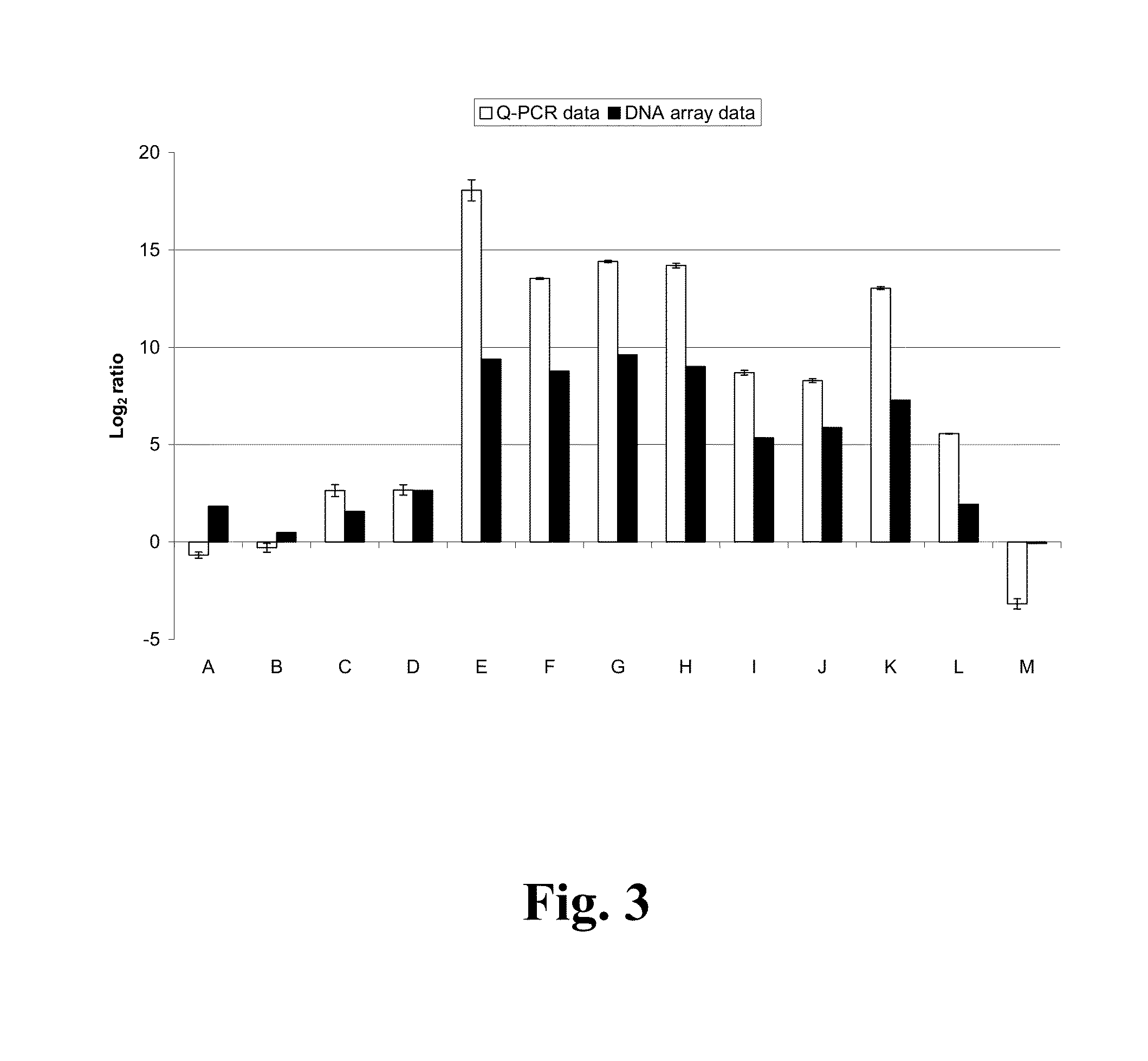Method for producing terpenes
- Summary
- Abstract
- Description
- Claims
- Application Information
AI Technical Summary
Benefits of technology
Problems solved by technology
Method used
Image
Examples
example 1
Identifying the Diterpene Cluster in Aspergillus nidulans
[0156]The selected cluster was identified as described by Bromann et al., 2012. The genes with InterPro domains IPR008949 ‘Terpenoid synthase’ and IPR008930 ‘Terpenoid cyclase’ were searched from the genome of Aspergillus nidulans FGSC A4. To find the potential terpene biosynthetic gene clusters with a positive regulator and characteristic genes for secondary metabolism, InterPro domains IPR001138 ‘Fungal transcriptional regulatory protein’, IPR002403 ‘Cytochrome P450, E-class, group IV’, and IPR001128 ‘Cytochrome P450’ were searched for in 20 kb genomic area around terpene synthase genes. Similar clusters were also found in Neosartorya fischeri, Microsporum canis, Trichoderma reesei, Neurospora crassa, Aspergillus clavus, Aspergillus fumigatus, Aspergillus niger, Aspergillus oryzae, Aspergillus terreus, Botrytis cinerea, Magnaporthe grisea, Fusarium graminearum, and Fusarium oxysporum, and the terpenoid clusters were mapped ...
example 2
Cloning of the Fungal Expression Vector for the Transcription Factor AN1599
[0158]Genomic DNA was extracted by homogenizing 300-500 mg of FGSC A4 mycelia grown over night in YES-medium. 500 μL of glass beads (Acid-washed glass beads, cat #G8772, Sigma), 500 μL 1× TE-buffer, pH 7,5 and 500 μL phenol-chloroform-isoamyl alcohol was added to 2 mL vial with mycelia and homogenized in Fast Prep-homogenizer at speed 6 for 25 seconds. Aqueous layer was separated with 5 minute centrifugation at 15 000 rpm at 4° C., and 650 μL of phenol-chloroform-isoamyl alcohol was added. DNA purification from the aqueous phase was continued according to phenol extraction and ethanol precipitation of DNA-protocol (Current Protocols in Molecular Biology). Concentration of the DNA was measured with Nanodrop (Thermo Scientific).
[0159]Open reading frame (ORF) of AN1599 (SEQ ID NO: 1) was amplified with PCR using 43 ng of genomic DNA extracted from Aspergillus nidulans FGSC A4 as template. Primer concentration wa...
example 3
Generating the AN1599 Transformant Strains
[0162]Conidia of Aspergillus nidulans strain FGSC A4 Glasgow wild type (veA+) (Fungal Genetics Stock Center, School of Biological Sciences, University of Missouri, Kansas City, 5007 Rockhill Road, Kansas City, Mo. 64110, USA) were inoculated in YES-medium [20 g Bacto™ Yeast Extract (Cat #212750, Becton, Dickinson and Company), 40 g sucrose (Calbiochem Cat #573113) and 30 g Difco™ Gelatin (Cat #214340, Becton, Dickinson and Company) per liter of dH2O] and grown at +24° C. in shaking flasks over night with 250 rpm. FGSC A772 (galD5,pyrG89;acrA1;chaA1) was grown in YES-medium supplemented with 10 mM uracil and 10 mM uridine at +37° C. in shaking flasks over night with 250 rpm. Aspergillus nidulans FGSC A4 and A772 mycelium was filtered through sterile Miracloth, and rinsed with +37° C. dH2O, and room temperature citrate buffer [0.8 M KCl, 0.05 M Na-citrate, pH 5.8]. Filtrated FGSC A4 mycelium was resuspended in 100 mL of room temperature citrat...
PUM
| Property | Measurement | Unit |
|---|---|---|
| Fraction | aaaaa | aaaaa |
Abstract
Description
Claims
Application Information
 Login to View More
Login to View More - R&D
- Intellectual Property
- Life Sciences
- Materials
- Tech Scout
- Unparalleled Data Quality
- Higher Quality Content
- 60% Fewer Hallucinations
Browse by: Latest US Patents, China's latest patents, Technical Efficacy Thesaurus, Application Domain, Technology Topic, Popular Technical Reports.
© 2025 PatSnap. All rights reserved.Legal|Privacy policy|Modern Slavery Act Transparency Statement|Sitemap|About US| Contact US: help@patsnap.com



